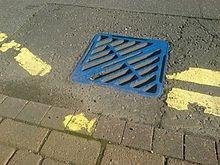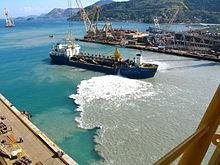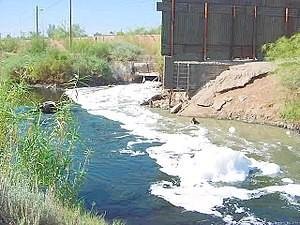POLLUTION SERIES #2: WATER POLLUTION
Hello steemians!! Today's post is in continuation of my pollution series and the topic for today is WATER POLLUTION. This is a bit personal to me due to the fact of me being a water resources student and I can tell you from a professional point of view and with all confidence that the water problem is much worse than its portrayed to the general public.
Water pollution can be defined as the contamination of water bodies (e.g. lakes , rivers , oceans, aquifers and groundwater ). It happens when pollutants reach these bodies of water, without treatment. Water pollution is a problem for the species and
ecosystems existing there. It affects plants and organisms living in the water. In almost all cases the effect is damaging not only to individual species and populations, but also to the wider biological communities . The color is mostly green or brown but normal water can be blue. Fertilizer is one of the major causes of water pollution, they are washed into various water bodies after application on plants.
As of 2007, half a billion Chinese had no access to safe drinking water. In addition to the acute problems of water pollution in developing countries , developed countries also continue to struggle with pollution problem, An estimated 580 people in India die of water pollution related illness every day.
90 percent of the water in the cities of China is polluted.
Many chemicals are naturally found in these bodies of water but today it is polluted by nitrates, phosphates, oil, acid from acid rain, and debris like sediments, fallen logs. and so it creates diseases to human and other living organisms for example they drink water from rivers which are mixed with poisonous chemicals which can effect them.
TYPES OF WATER POLLUTION
Water pollutants can be classified into two (none point and point source)
None point source
Non point source pollution talks about the contamination that does not originate from a single discrete source. NPS pollution is often the total effect of small amounts of contaminants gathered from a large area. A prominent example is the leaching out of nitrogen compounds from fertilized agricultural lands. Nutrient runoff in storm water from an agricultural field or a forest are also cited as examples of NPS pollution.
 image sourceBlue drain and yellow fish symbol used by the UK Environment Agency to raise awareness of the ecological impacts of contaminating surface drainage
image sourceBlue drain and yellow fish symbol used by the UK Environment Agency to raise awareness of the ecological impacts of contaminating surface drainage
Point source
Point source water pollution talks about the contaminants that enters a waterway from a single, identifiable source, such as a pipe or
ditch . Examples includes discharges from a sewage treatment plant, a factory, or a city storm drain. They might also include municipal storm sewer systems, or industrial storm water, such as from construction sites.
 image sourcePoint source pollution at a
image sourcePoint source pollution at a
shipyard in Rio de Janeiro, Brazil.
Groundwater pollution, refers to also as groundwater contamination, is not as easily categorized as surface water pollution. Groundwater aquifers are prone to contamination from sources that may not directly affect surface water bodies, and the distinction of point vs. non-point source is not irrelevant.
CAUSATIVE AGENTS
The contaminants leading to pollution in water include a wide array of chemicals ,
pathogens , and physical changes such as high temperature and discoloration. While many of the chemicals and substances that are regulated may be naturally occurring ( calcium ,
sodium, iron, manganese , etc.) the concentration is often the tip-off in determining what is a natural component of water and what is a contaminant. High concentrations of naturally occurring substances can have negative impacts on aquatic flora and fauna.
Oxygen reducing substances may be natural materials such as plant matter (e.g. leaves and grass) as well as man-made chemicals. Other natural and anthropogenic substances may cause turbidity which prevents light and disturbs plant growth, and clogs the gills of some fish species.
PATHOGENS PRESENT
- Burkholderia pseudomallei
- Cryptosporidium parvum
- Giardia lamblia
- Salmonella
- Norovirus and other viruses
- Parasitic worms
ASSOCIATED DISEASES
- Cholera
- Guinea worm disease
- Typhoid
- Dysentery
I hope y'all enjoyed my second entry in my pollution series subsequent topic to follow. Please upvote, resteem and follow me God bless you!!

We need such orientation in nigeria
You are right bro
Love your article. Its very touching. We need to become aware fast of all this thing we doing to harm the nature.
Thank you, I hope people will start making changes
A very vast topic. This was part of my project in my final year in school.
Thanks for reading
Such great awareness..... Keep it up.
Thank you
Congratulations! This post has been upvoted from the communal account, @minnowsupport, by adekolapo from the Minnow Support Project. It's a witness project run by aggroed, ausbitbank, teamsteem, theprophet0, someguy123, neoxian, followbtcnews, and netuoso. The goal is to help Steemit grow by supporting Minnows. Please find us at the Peace, Abundance, and Liberty Network (PALnet) Discord Channel. It's a completely public and open space to all members of the Steemit community who voluntarily choose to be there.
If you would like to delegate to the Minnow Support Project you can do so by clicking on the following links: 50SP, 100SP, 250SP, 500SP, 1000SP, 5000SP.
Be sure to leave at least 50SP undelegated on your account.